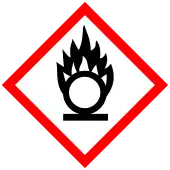 | |
| Names | |
|---|---|
| IUPAC name
Rubidium perchlorate | |
| Other names
Perchloric acid rubidium salt, Rubidium chlorate(VII), Rubidii perchloras (lat.) | |
| Identifiers | |
3D model (JSmol) |
|
| ChemSpider | |
| ECHA InfoCard | 100.033.476 |
| EC Number |
|
PubChem CID |
|
CompTox Dashboard (EPA) |
|
| |
| |
| Properties | |
| RbClO4 | |
| Molar mass | 184.918 g/mol |
| Appearance | Colorless crystals |
| Density | 2.878 g/cm3 2.71 g/cm3 over 279 °C |
| Melting point | 281 °C (538 °F; 554 K) |
| Boiling point | 600 °C (1,112 °F; 873 K) (decomposes) |
| see chart | |
Solubility product (Ksp) |
3×10−3[2] |
| Hazards | |
| GHS labelling: | |
  | |
| Warning | |
| H272, H302, H315, H319, H332, H335 | |
| P210, P220, P221, P261, P264, P270, P271, P280, P301+P312, P302+P352, P304+P312, P304+P340, P305+P351+P338, P312, P321, P330, P332+P313, P337+P313, P362, P370+P378, P403+P233, P405, P501 | |
| NFPA 704 (fire diamond) | |
Except where otherwise noted, data are given for materials in their standard state (at 25 °C [77 °F], 100 kPa).
Infobox references | |
Rubidium perchlorate, RbClO4, is the perchlorate of rubidium. It is an oxidizing agent, as are all perchlorates.
Preparation and properties
Rubidium perchlorate can be obtained through the careful heating of a rubidium chlorate solution, leading to a disproportionation reaction with the release of oxygen gas:[3]
- 2 RbClO3 → RbClO4 + RbCl + O2
When heated, it decomposes into the chloride and oxygen:[4]
- RbClO4 → RbCl + 2 O2
It has two polymorphs. Below 279 °C, it crystallizes in orthorhombic crystal system with lattice constants a = 0.927 nm, b = 0.581 nm, c = 0.753 nm. Over 279 °C, it has a cubic structure with lattice constant a = 0.770 nm.[1]
Table of solubility in water:[1]
| Temperature (°C) | 0 | 8.5 | 14 | 20 | 25 | 50 | 70 | 99 |
|---|---|---|---|---|---|---|---|---|
| Solubility (g / 100 ml) | 1.09 | 0.59 | 0.767 | 0.999 | 1.30 | 3.442 | 6.72 | 17.39 |
References
- 1 2 3 F. Brezina, J. Mollin, R. Pastorek, Z. Sindelar. Chemicke tabulky anorganickych sloucenin (Chemical tables of inorganic compounds). SNTL, 1986.
- ↑ John Rumble (June 18, 2018). CRC Handbook of Chemistry and Physics (99 ed.). CRC Press. pp. 5–189. ISBN 1138561630.
- ↑ Abegg, R.; Auerbach, F. (1908). Handbuch der anorganischen Chemie. Vol. 2. S. Hirzel. p. 431.
- ↑ d' Ans, Jean; Lax, Ellen (1997). Taschenbuch für Chemiker und Physiker. 3. Elemente, anorganische Verbindungen und Materialien, Minerale. Vol. 3 (4th ed.). Berlin: Springer. p. 686. ISBN 3-540-60035-3. OCLC 312750698.
External links
This article is issued from Wikipedia. The text is licensed under Creative Commons - Attribution - Sharealike. Additional terms may apply for the media files.
